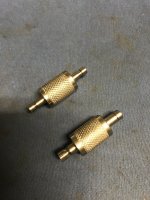So long story short, last weekend I shot my established load through my LMT AR10 and everything seemed normal until I attached my buddy's Surefire SPS-300 suppressor. Once the suppressor was attached, my loads started blowing primers out of the pockets. I didn't notice until one of the loose primers caused a malfunction.
Prior to ever attaching a suppressor, my established load has never showed excessive pressure signs (heavy ejector smearing and primer cratering/flattening).
Firearm:
LMT AR10 6.5CM 20" SS barrel.
My load:
-Hornady 147gr bullet
-Hornady brass (likely 5th or 6th loading)
-CCI No. 34 primers.
-40.9 grains H4350
-Velocity 2635fps (per Magneto Speed)
Un-Suppressed Brass Fired:
Suppressed Brass Fired
Environmentals: 65 degrees F.
I'm wondering if this is a known issue when using suppressors? Was my brass at the end of it's usable life at 5-6 firings? I would really like to not go back to the drawing board and develop a new load. I will upload photo of the brass shot un-suppressed and suppressed when I get home.
Any help would be greatly appreciated!
Prior to ever attaching a suppressor, my established load has never showed excessive pressure signs (heavy ejector smearing and primer cratering/flattening).
Firearm:
LMT AR10 6.5CM 20" SS barrel.
My load:
-Hornady 147gr bullet
-Hornady brass (likely 5th or 6th loading)
-CCI No. 34 primers.
-40.9 grains H4350
-Velocity 2635fps (per Magneto Speed)
Un-Suppressed Brass Fired:
Suppressed Brass Fired
Environmentals: 65 degrees F.
I'm wondering if this is a known issue when using suppressors? Was my brass at the end of it's usable life at 5-6 firings? I would really like to not go back to the drawing board and develop a new load. I will upload photo of the brass shot un-suppressed and suppressed when I get home.
Any help would be greatly appreciated!
Last edited:


